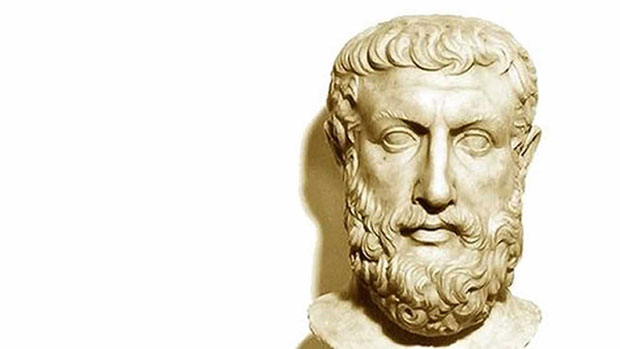
Parmenides was a fifth-century BCE Greek philosopher, belonging to the city of Elea. Under the guidance of his teacher, Xenophanes of Colophon, he founded the Eleatic School of philosophy, which classifies truth on the basis of pure logic and rationality, and does not accept sense experiences as valid. He was also known for leading an exemplary life; the Parmenidean lifestyle serves as a proverb for the Greeks.
Parmenides is one of the few known philosophers before Socrates. He gave up the customary prose of his Ionic ancestors and wrote a poem in hexameter, which survives in bits and pieces. The poem titled ‘On Nature’ was originally divided into three parts, namely the proem, the alethia and the doxa. It is an account of the narrator’s journey to meet a goddess, who unveils to him the secrets of existence.
The ‘Proem’ contains the introductory verses of ‘On Nature’. Parmenides describes the journey of a young man who travels from the darkness of the night (ignorance) to the bright light (enlightenment) of the day, to meet a goddess who imparts him with knowledge of truth based on facts, and informs him of the validity of human opinion, which represents an aspect of the truth.
The ‘Alethia’ or ‘The Way of Truth’ debates the art of distinguishing the truth from opinions formed by humans. Parmenides states his famous theory of truth, according to which reality of an object can be judged based on the phenomenon that it is, and that it is not. There is nothing in-between existence and non-existence.
In the third part of his poem, the ‘Doxa’ or ‘The Way of Opinion’, Parmenides shifts his philosophy to the origin of the universe by explaining the structuring of cosmos and deals with Pythagorean scientific theories. He further states that our perception of the world, formed through our sensory experiences, is often faulty and illusory.
Parmenidean philosophy focuses on finding the truth through reasoning and logic only, without letting experiences and senses interfere with it. You can reach the truth by basing it on two possibilities: whether the object exists or not. Parmenides believed that we cannot speak for an object which is not there, as it would be far from truth.
By not speaking about non-existing phenomena and objects, Parmenides wants us not to get confused in the path between being and non-being: the path on which we are governed by our senses and which mixes both the existing and non-existing worlds.
Thus he insists on questioning reality by first accepting that it exists. Rational inquiry should not include non-beings, as per Parmenides. Through this method, he drew out the conclusion that the ‘existing’ is continuous, perfect, non-perishable and ingenerated.
What truly is surprising for Parmenides’ readers is the fact that after stressing on the unimportance of observations and senses, he proceeds by explaining how our observed world came into being. One possible explanation, according to commentators, is that perhaps Parmenides agrees that there are two kinds of realities, one greater than the other. The greater reality is what exists and how it really is, as explained in the ‘On Truth’ section of his poem. The inferior reality is based on our observations, which is often delusional. Thus the science of cosmogony would be best described through the lower level of reality.
Parmenides’ views and philosophy has continued to inspire thinkers over the millennia. Plato was largely influenced by him, in turn affecting the spectrum of Western philosophy. The Eleatic school of thought has also benefited greatly from Parmenides’ works.